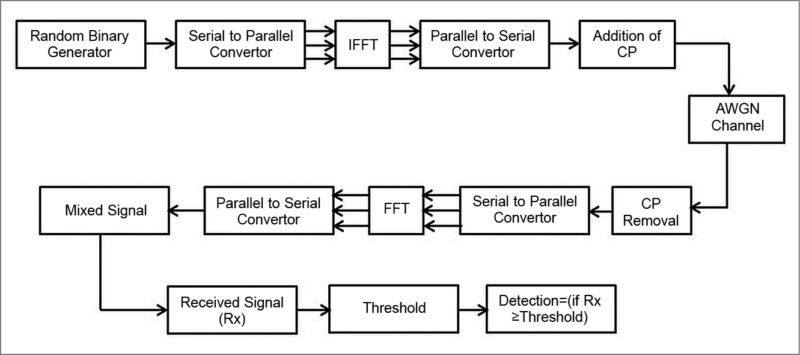Cognitive radio is an intelligent technology that improves radio spectrum utilisation. The increasing number of new devices has caused congestion in the ISM (industrial, scientific and medical) radio band. Federal Communications Commission allows unlicensed users (secondary users) to operate in the white space without causing interference to licensed users (primary users). Cognitive radio provides a solution to the additional spectrum requirement for efficient spectrum utilisation. It is capable of sensing and sharing the unused spectrum with unlicensed users.
To enhance the spectrum efficiency, cognitive radio is integrated with different orthogonal frequency-division multiplexing (OFDM) frameworks. Parameters such as probability of detection (Pd) vs probability of false alarm (Pfa), Pd vs signal-to-noise ratio (SNR), and bit-error rate (BER) vs SNR for each OFDM framework are calculated and analysed using matched filter detection.
Matched filter method can detect the free portion of primary users’ spectrum and allocate it to secondary users, thus minimising spectral overcrowding. A matched filter is obtained by cross-correlating an unknown signal with a known signal to detect the presence of a well-known signal. It is also known as optimal linear filter. In matched filter detection, use of a dynamic threshold improves the spectrum sensing efficiency as well as detection performance at low SNR values.
Integration of cognitive radio with OFDM for better spectrum utilisation requires more priori knowledge of the signal for detection. So, the received signal is demodulated and matched filter applied to the signal. Detection time for matched filter is very less than with other detection methods. Hence, research on integration of cognitive radio with OFDM system is in high demand.
In this article, an OFDM system with and without cyclic prefix (CP), filter at only the transmitter side and filter at both the transmitter and receiver sides, integrated with matched filter detection, is implemented and analysed. The project is implemented using MATLAB version 2013b. It overcomes the requirement of a high SNR in energy detection by using cyclostationary detection. Detection is also faster than with other energy detection schemes.
Matched-filter OFDM model
Block diagram of the proposed matched-filter detection is shown in Fig. 1. A random binary signal is brought forth in a serial way and converted into parallel form. To analyse the signal in time domain, inverse Fast Fourier transform (IFFT) is applied to the signal and it is again converted from parallel into serial form for addition of the CP and then sent through an additive white Gaussian noise (AWGN) channel. At the receiver, the CP is removed, serial form of signal is converted into parallel form and FFT is applied to each symbol for analysing the signal in the frequency field. After demodulation, it is cross-correlated with a local oscillator signal, which is dislodged in time. Finally, the picked-up signal is compared with the threshold for sensing of the spectrum. A hypothesis is formulated that if the received signal is larger than the threshold, there will be detection, otherwise not.

The results are thoroughly analysed by using a mathematical model of cognitive OFDM system and code is implemented using MATLAB programs (filter_tx.m, filter_tx_rx.m, pd_pfa.m, pd_pfa_cp.m, pd_pfa_rx.m, pd_pfa_tx.m, pd_snr.m, pd_snr_cp.m) included in the source folder given below.
Analysis results
BER vs SNR for OFDM with and without CP. Analysis of BER vs SNR for OFDM with and without CP is shown in Fig. 2. BER decreases as SNR increases. From 0dB to 3dB, BER for OFDM with and without CP is approximately equal. But as SNR increases beyond 3dB, BER performance of OFDM with CP is a lot better than OFDM without CP. Analytical results prove that the OFDM system with CP is much more efficient and authentic with less ISI and BER than OFDM without CP.

BER vs SNR for OFDM with filter at transmitter and receiver. Analysis of BER vs SNR for OFDM with a filter at both the transmitter and the receiver is shown in Fig. 3. For OFDM system with filter at the transmitter, BER decreases with the increase of SNR. But OFDM with filter at both transmitter and receiver sides gives a constant BER for all SNRs. This proves that OFDM with filter at the transmitter is more beneficial than OFDM with filter at both the transmitter and the reciever.

Pd vs SNR for OFDM with and without CP. Analysis of Pd vs SNR for OFDM with and without CP is shown in Fig. 4. Pd increases with the increase of SNR. OFDM system with CP is capable of detecion for smaller SNRs, whereas detection for OFDM without CP needs a high SNR.

No comments:
Post a Comment